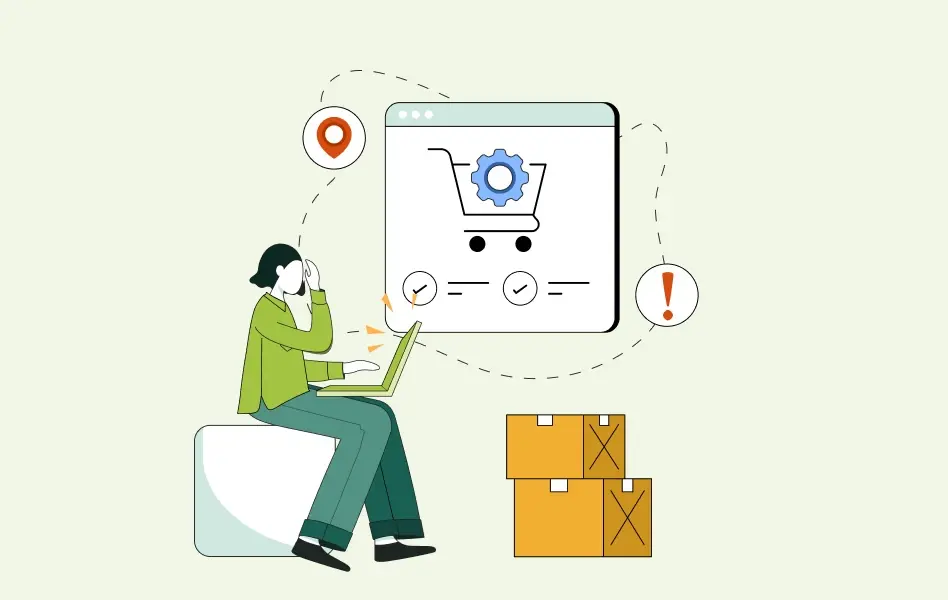Contents
B2B order processing is full of challenges – but fixing them can save up to 30% in costs and boost efficiency by 40%.
Key issues include manual data entry errors, delays in order approvals, and disconnected systems. These inefficiencies cost businesses billions annually and frustrate customers who now expect faster, self-service options.
Here’s how to address these problems:
-
-
- Automate processes: Reduce errors and cut order times from days to hours.
- Integrate systems: Sync ERP and order management for real-time updates.
- Streamline approvals: Use clear workflows and tools to speed up decisions.
- Centralize information: Ensure teams and customers access accurate order data.
-
With the right tools and strategies, businesses can improve order accuracy, speed, and customer satisfaction – critical in a market shifting toward digital-first solutions.
Let’s break down the key challenges and solutions.
Top B2B order processing problems
B2B order processing comes with challenges that can heavily influence operations and profits. Studies reveal that inefficiencies and miscommunication cost businesses as much as $1.2 trillion annually.
1. Data entry mistakes
Manual data entry is a frequent weak point in B2B processes. On average, it has an error rate of 4.2%, with some cases reaching as high as 7%. Automation, by comparison, is far less prone to mistakes, with humans making 100 times more errors.
Here’s a real-world example: Unity Technologies reportedly lost $110 million due to data errors that misdirected its ad targeting efforts.
2. Slow order approvals
Delays in order approvals can severely disrupt B2B workflows. Processing a single purchase order can cost anywhere from $50 to $1,000. These delays often arise from:
| Common causes of approval delays | Impact on business |
|---|---|
| Complex multi-stage workflows | Higher operational costs |
| Unclear communication channels | Missed sales opportunities |
| Limited resources | Lower team morale |
| Approval authority conflicts | Strained client relationships |
| High request volumes | Slower revenue recognition |
Almost 75% of B2B buyers say they would switch to a competitor if it offered better purchasing options. This underscores the importance of efficient approval processes for keeping customers happy.
3. Disconnected systems and teams
Fragmented systems create major operational hurdles. A surprising 41% of employees in small and medium-sized businesses still transfer data manually between systems. This lack of integration leads to:
-
-
- 73% of customers are experiencing inconsistent service.
- 64% of employees lose productivity, with some wasting over 30 minutes daily.
- As integrated systems, lower profits can boost average order values by 73%.
-
Disconnected systems can also result in compliance issues. For instance, Amazon France was fined €32 million for GDPR violations tied to poor system integration in its warehouse and order management processes.
Upgrading and integrating systems is crucial. The following section will explore actionable solutions to address these challenges.
How to fix order processing issues
Inefficient order processing can lead to delays, errors, and lost revenue. Businesses can enhance efficiency and scale operations seamlessly by leveraging automation, integrating ERP systems, and streamlining approvals. Here’s how:
1. Using order automation tools
Automation can lower processing costs by 10–15% and cut order times from days to just hours.
WizOrder’s AI-driven automation helps wholesalers simplify order processing by:
-
-
- Checking data against predefined rules
- Prioritizing and routing orders
- Managing complex, multi-line orders
- Ensuring compliance with regulations
-
For example, Graybar Electric used Conexiom’s solution to scale from 5 pilot projects to serving 1,500 customers and processing 83,000 documents.
Once automation tools are in place, the next step is integrating your ERP system to unify order data.
2. Connecting ERP with order systems
ERP integration is key to keeping data accurate across all systems. A study found that 95% of companies struggle with order management issues, and 91% plan to upgrade their ERP systems to tackle these problems.
| Integration benefits | Impact on operations |
|---|---|
| Real-time inventory updates | Prevents overselling |
| Automated data synchronization | Cuts down on manual entry |
| Centralized customer details | Enhances service consistency |
| Streamlined workflows | Speeds up order fulfillment |
To integrate your ERP effectively, start by mapping order types and identifying critical data points. Then, choose your integration method (API, EDI, or sFTP) and set up two-way data synchronization.
3. Making approvals faster
Once your ERP system is integrated, speeding up approval workflows is the next priority. Faster approvals can transform operations, and tools like SAP Business One offer automated alerts and workflows that significantly reduce delays.
Here’s how you can improve approval processes:
-
-
- Establish clear approval hierarchies
- Define escalation paths for urgent cases
- Use parallel workflows for complex orders
-
These methods deliver results. For instance, a building products distributor improved order efficiency by 10× and cut errors by 90% using automated workflows and integrated systems.
Enhancing order visibility for teams and customers
Keeping teams and customers informed is essential for smooth operations and strong relationships. A centralized order management system and real-time updates ensure transparency, efficiency, and better customer experiences.
1. One source for order information
A centralized Order Management System (OMS) is a single source of truth for key data like orders, inventory, customers, and payments. This unified approach simplifies operations and strengthens customer relationships by enabling proactive communication.
| Information type | Benefits of centralization |
|---|---|
| Order status | Easy access for all departments |
| Inventory levels | Real-time stock updates |
| Customer data | Full purchase history |
| Payment details | Simplified reconciliation |
For example, WizCommerce’s platform syncs orders, customer details, and product information across sales channels and ERPs. It provides instant access to order statuses, invoices, and shipment tracking. This level of centralization helps teams work more efficiently and improves communication with customers.
2. Keeping customers informed
When teams access real-time order data, transparent and timely customer communication becomes more manageable. Considering that 91% of consumers track their packages, and 39% check updates daily, meeting these expectations is crucial.
To keep customers informed, businesses can take these steps:
-
-
- Automate notifications: Send updates for order confirmations, processing changes, shipping details with tracking links, and delivery confirmations.
- Offer self-service tools: Platforms like ShopWorks’ ManageOrders let customers check order statuses, track shipments, and make payments through desktop and mobile devices.
- Personalize tracking experiences: DRMTLGY, for instance, enhances customer engagement with a custom order tracking page that integrates with tools like Klaviyo and Gorgias.
-
Transparency is even more critical for B2B orders. Real-time updates help manage complex shipments and multiple stakeholders. Automated tracking systems can provide estimated delivery times and flag potential delays before they disrupt schedules.
Optimizing order processing with data-driven insights
Monitoring key metrics and using real-time insights help optimize order processing, reduce costs, and enhance customer satisfaction. Here’s how:
1. Order processing metrics
Keeping an eye on key performance indicators (KPIs) is crucial for smooth order processing.
| Key metric | Target range | What it measures |
|---|---|---|
| Perfect order rate | 90%+ | Orders delivered complete, on time, and damage-free |
| Internal order cycle time | 24 – 48 hours | Time from order receipt to shipping |
| Order fulfillment cycle time | 2 – 5 days | Total time from order placement to delivery |
| Order accuracy | 98%+ | Correctly picked and packed orders |
| Channel performance | Varies | Sales percentage compared to forecast by channel |
If the perfect order rate dips below 90%, it’s time to investigate potential problem areas. For instance, Bonded Logistics enhanced its tracking capabilities with Cadence WMS, a system that provides real-time warehouse monitoring. Dave Jesse, the company’s COO, noted that this tool has improved staff adaptability and client transparency.
Once the metrics identify problem areas, businesses can focus on specific strategies to address those gaps.
2. Tips for better performance
Using insights from data, businesses can refine processes with real-time tracking, detailed workflow evaluations, and more intelligent decision-making. Here’s how to boost efficiency:
- Real-time monitoring systems
Platforms like WizCommerce offer customizable dashboards to track order status, inventory, and shipping performance in real time. This level of visibility allows businesses to catch and resolve problems before they impact customer satisfaction.
- Process analysis and optimization
Regularly reviewing workflows can help pinpoint bottlenecks and areas for improvement. Focus on processes given below:-
-
- Streamlining order entry and approval steps
- Improving warehouse operations
- Evaluating shipping carrier reliability
- Simplifying returns processing
-
-
- Data-driven decision making
Esker’s research highlights that “Real-time KPI access simplifies order management”. Use these KPI’s to:-
-
- Predict product demand more accurately
- Adjust inventory levels efficiently
- Choose cost-effective shipping methods
- Enhance warehouse operations
- Strengthen communication with customers
-
-
Conclusion
The B2B order processing market is growing fast, with projections showing it could reach $25.65 trillion globally by 2028. This growth pushes businesses to keep up or risk falling behind.
The benefits of streamlined order processing are clear: up to 30% cost savings, 40% efficiency improvements, 20% better inventory accuracy, and 15% higher fulfillment rates. It’s also worth noting that 75% of B2B buyers now prefer digital self-service options.
Key trends shaping the future include:
-
-
- AI and automation: Smarter systems for order processing and predictive analytics.
- Integrated systems: Connecting tools like ERP, accounting, and inventory platforms for smoother operations.
- Customer-focused solutions: Offering real-time updates, transparency, and self-service features.
-
These approaches highlight how B2B order processing is evolving to meet modern demands.









































































































